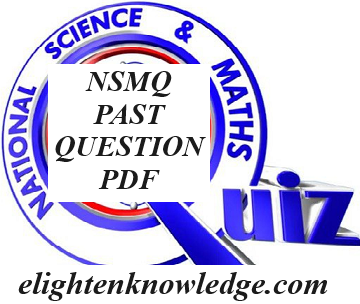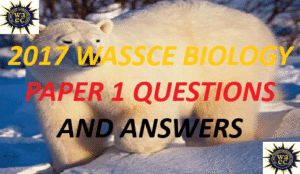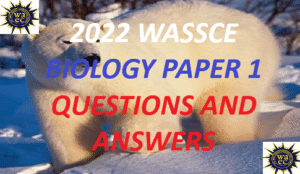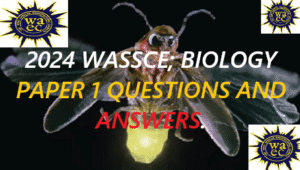NSMQ PAST QUESTION PDF; CHEMISTRY (01)

NSMQ PAST QUESTION PDF; CHEMISTRY (01)
What is the most likely mode of decay for each of the following nuclides?
- Carbon – 15
Ans: Beta decay
- Uranium – 238 (atomic number 92)
Answer: alpha decay
- Nitrogen – 12
Ans: positron emission (or electron capture)
Identify the following species found on the Periodic Table given the information below:
- Mass number 33; neutron number 18; number of electrons 18
Ans: P3–
- Mass number 55; neutron number 30; number of electrons 22
Answer: Mn3+
- Mass number 66; neutron number 36; number of electrons 28
Ans: Zn2
Give the name of the major product formed in each of the following reactions
- The Reaction of benzene with chlorine in the presence of aluminum chloride
Ans: chlorobenzene
- The reaction of 2-methylpropane with a limited amount of chlorine gas
Answer: 2-chloro-2-methyl propane
- The reaction of butanoic acid and methylamine
Ans: N-methyl butanamide
During the production of pure iron, Fe2O3 reacts with carbon monoxide, CO, according to the reaction: Fe2O3 + 3 CO → 2Fe + 3CO2
- How many moles of phosphorus is present in 14.2 g of P4O10? Take the atomic mass (g/mol) of phosphorus and oxygen as 31 and 16, respectively.
Ans: n(P) = 0.20 mol
n(P4O10) = 14.2/284 = 0.050 mol; P = 4 × 0.05 = 0.20 mol
- Determine the sum of the stoichiometric coefficients of all reactants and products present in a balanced equation of the reaction: C3H8 + O2 → CO2 + H2O
Answer: 13
C3H8 + 5O2 → 3CO2 + 4H2O
- How many unpaired electrons are present in the molecule NO?
Ans: one (1)
Give the name of the major product formed from the reaction of HBr with each of the following:
- 1-pentene
Ans: 2-bromopentane
- 2-methyl-2-butene
Answer: 2-bromo-2-methylbutane
- Cyclohexene
Ans: Bromo cyclohexane (or 1-bromo cyclohexane)
- What mass of oxygen is needed to produce 90 g of water given that an excess amount of hydrogen reacts? Take the atomic mass (g/mol) of H and O as 1.0 and 16 respectively.
Ans: 80 g
Mol of H2O = 90/18 = 5.0 mol.
n O2 = 5.0/2 = 2.5 mol Hence mass = 2.5 × 32 = 80 g
- Determine the mass of Na2CO3 needed to produce 0.150 mol of carbon dioxide gas in a thermal decomposition reaction. Take the atomic mass (g/mol) of Na, C, and O as 23.0, 12.0 and 16.0 respectively.
Ans: 15.9 g
Molar mas of Na2CO3 = 106 since mole ratio is 1:1, mass = 106 × 0.150 = 15.9 g
- Based on a reaction with solid carbon, determine the mass of oxygen needed to produce 16.8 g of carbon monoxide given that, oxygen is limited. Take the atomic mass (g/mol) of C and O as 12 and 16 respectively.
Ans: 9.6 g
Mol of CO = 16.8/28 = 0.60 mol mol of O2 = 0.60/2 = 0.30 mol
Mass of O2 = 9.6 g
- Given Avogadro’s number as 6.0 × 1023, how many atoms of oxygen are present in 4.0 moles of SO3?
Ans: 7.2 × 1024
Number of atoms = 6.0 × 1023 × 4 mol × 3 O atoms = 7.2 × 1024
- Determine the sum of the stoichiometric coefficients of all reactants and products present in a balanced equation of the reaction: C6H8 + O2 → CO2 + H2O
Answer: 19
C6H8 + 😯2 →6CO2 + 4H2O
- What is the maximum number of hydrogen bonds formed by a water molecule in ice?
Ans: four (4)
Indicate the values of all quantum numbers permissible for the following orbitals
- 4p
Ans: n = 4, l = 1, ml = -1, 0, +1
- 3d
Answer: n = 3, l = 2, ml = -2, -1, 0, +1, +2
- 5s
Ans: n = 5, l = 0, ml = 0
State and explain the effect of each of the following actions on the equilibrium of the reaction
- An increase in pressure
Ans: Equilibrium will shift toward the formation of more product (right/forward)
An increase in pressure will favour the side with fewer moles of gas. Mole of reactants is 3 and moles of product is 2, hence pressure will favour formation of product/forward reaction
- An increase in temperature
Ans: Equilibrium will shift toward the formation of more reactants (left/backwards)
Since reaction is exothermic, increase in temperature will favour the formation of reactants
- A decrease in the amount of oxygen gas
Ans: Equilibrium will shift toward the formation of more reactants (left/backwards)
More SO3 will breakdown to form O2 in other to negative the effect of the reduced concentration of O2.
Download NSMQ Past Question; Chemistry (01)
Join us on Our WhatsApp platform for more





